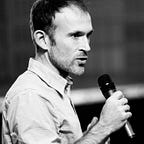Between a Rock and a Hard Place
… the amazing case of Aron Ralston.
Aron Ralston was out exploring in the Bluejohn Canyon in Utah in 2003 when he fell down a crevasse, just ahead of a large boulder that then literally trapped him “Between a Rock a Hard Place” (2004). With only two burritos, 350ml of water and a blunt knife he quickly understood that there was no way that he could move the rock that crushed his lower right arm against the canyon wall. After being trapped for 5 days, he had to drink his urine and, expecting the worst, he carved his name, the date, and final messages to his family onto the sandstone wall of the canyon. However, after waking up on the sixth day, he realised there was a chance that he could survive. His decomposing arm could be broken and he could cut through the tendons and everything else with his blunt knife.
It was a simple choice. Either he was going to die there with both of his arms remaining attached to his body — or he was going to survive, but without his lower right arm.
Leaving the main arteries until last, he did the self-surgery in about an hour and then, after 10km of hiking during which he lost around 25% of his blood, he found a Dutch family on vacation who gave him food, drink and everything else he needed. The extraordinary details can be seen in the movie “127 hours”.
Thinking clearly about the climate crisis
The blunt truth is that this is the kind of situation we are in with climate change. We do not have a choice — the law of gravity which pinned the 360kg rock onto Aron Ralston’s arm is just as stubborn as the laws of physics and chemistry that determine the atmosphere and the climate.
Denial does not change the situation, neither does bargaining. Either we do immediate and major surgery to the infrastructure of our societies — with unprecedented levels of focus and investments, or we will push the climate system into a viciously spasmodic and unbalanced state.
COP26 in Glasgow is another chance to look at the truth. It is another chance for nations to come forward with commitments that are made in full recognition of the remaining carbon budget.
It should not be possible for a politician to talk use the word “ambitious”, and “net zero by 2050” in the same sentence. What is ambitious about that? Quite simply, the only thing that is ambitious is to keep global heating to a safe level.
The rest is cowardly.
In the bluntest terms, we need to be prepared to chop our arm off.
Bold laws
The changes required in the 1970s, when we had a very complete understanding of the science, could have been implemented with ease. Even as late as 1995, when the first COP was held in Berlin, the bending of the emissions curve would have been very achievable with a determined effort.
We are now in a similar position to Aron.
Very bold decisions have to be taken now at a major system level. The size of the reductions necessary for 1.5°C are way beyond anything in public discourse at the moment; even 2°C is difficult to imagine from here given the lack of momentum. COP26 Glasgow simply must give a massive policy signal to the markets. Infrastructure change takes years, and our ability to deal with the problem with small individual gestures was toasted many years ago.
Just as Aron Ralston had to get his reason to somehow override his instincts, we have to set in place some laws that frame our ambitions for economic growth within the boundaries defined by the science of the carbon budget.
Is this a bit weird? Is it unprecedented and uncomfortable? Yes. But, honestly, what is the alternative?
If we wait, we will lose more than an arm.
Without underestimating the losses that the changes required will cause to some industries, there has been the weirdest skewed thinking in our public discourse about climate change. It has been as if the arm has been shouting to the rest of the body, “… yes, but don’t you see… it is completely unrealistic to live without me”.
Not only that, but in our situation is actually a much better one than the mind-melting choice that Aron was faced with. The systemic reforms needed to meet the promise of the Paris Agreement are so deeply enriching and positive for us all anyway.
Which side are we on?
Who are the realists in climate change debate?
Who are the idealists?
Matthew Pye
For the latest figures of the emissions reductions required for both 1.5°C and 2°C go to www.cut11percent.org
All the science has been analysed, checked and endorsed by the worlds’ most eminent scientists.
Why is this information not more publicly known?
Maybe that is a question for Aron to help us answer.
